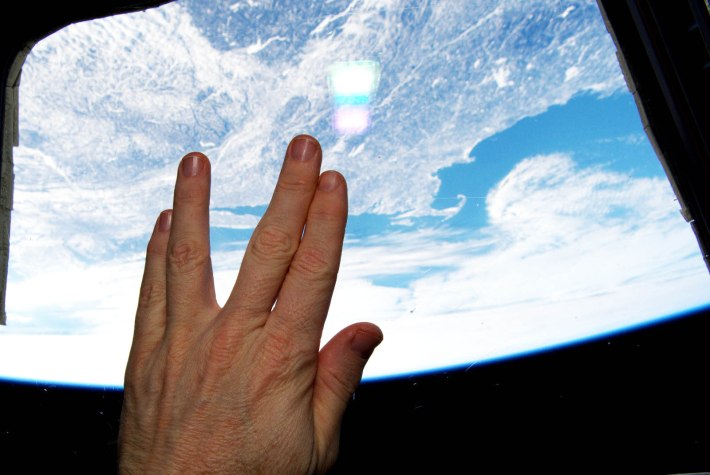
Good afternoon, everyone.
Some of you might be wondering about my Facebook cover photo. Many will recognize it as the “Live long and prosper” symbol from Star Trek; many might connect it to the recent death of Leonard Nimoy, who played Spock and who originated that symbol.
Here is a little-known fact: the hand symbol itself does not mean “Live long and prosper,” although it’s often accompanied by those words. The hand gesture itself symbolizes “infinite diversity in infinite combinations” to the Vulcan people, Spock’s race.
And that just says everything about Star Trek.
As we move further and further into the 21st century, there are an increasing number of people who have never seen the Star Trek Original Series. To these folks, Star Trek (and Nimoy’s work as Spock) may seem just one of many science fiction series that have cult followings for whatever reason.
This is not the case. The Original Series of Star Trek, in which Leonard Nimoy played Spock is empirically special. It’s unique. This is not because it is best, but because it is first. To understand how truly special the Star Trek Original Series is, you have to understand the historical context for it:
The very first Star Trek episode aired in 1966. Less than two decades earlier the United States had put Japanese Americans into internment camps, and ended its long, bloody military campaign in the Pacific with nuclear weapons.
The U.S. was now neck-deep in a Cold War with Russia and its communist ally China, in which many Americans sincerely believed they would be killed in a nuclear holocaust: this was the era of building fallout shelters under your house, and having “what to do in case a nuclear bomb goes off nearby” drills in public schools.
The U.S. civil rights movement was also at its most dangerous: the mob- and police-brutality upon which the events of the recent movie “Selma” were based had happened a year earlier, to peaceful protesters for racial equality; Martin Luther King, Jr. would be assassinated two years after Star Trek began to air.
Title VII of the Civil Rights act, banning business policies against hiring women, had just been passed a year earlier. The term “sexism” would not be invented for two more years.
John F. Kennedy had been elected less than a decade earlier, amidst concerns that he would be untrustworthy as president because he’d be the first who was a Catholic Christian, instead of a Protestant Christian like most Americans and every president before him.
NASA was less than a decade old. Humans were making their first forays outside of Earth’s atmosphere in one- and two-person capsules with less leg room than most cars. No human had yet walked on any celestial body other than Earth.
So it was understandably pretty insane when Star Trek aired centered entirely upon a starship whose most essential half-dozen or so staff members included a black woman as bridge communications officer, an ambiguously Chinese-or-Japanese navigator, a Russian weapons expert, and a pointy-eared alien who followed a philosopher no one on Earth had ever heard of as second-in-command.
The original vision of Star Trek creator Gene Roddenberry was even more radical; he had wanted Captain Kirk’s second-in-command to be a woman too, but had been forced to change that by the television network. He still managed to get in Uhura (a black woman serving as officer on the bridge of a starship in 1966), Chekov (Russian as hell in the middle of the Cold War, and in charge of weapons, of all things), and Sulu (possibly Chinese or Japanese, either way someone we had recently been or expected to be at war with).
So it was that Star Trek featured not only the first interracial kiss ever aired on television (Captain Kirk and Communications Officer Uhura), but also a whole ton of optimism about a future in which Earth knew no more wars and citizens of formerly enemy nations worked together without anyone thinking it was a big enough deal to comment on.
Leonard Nimoy ended up being almost as much of a shaping force behind Star Trek as Gene Roddenberry, who originated the concept. Nimoy went on to direct most of the Star Trek movies throughout the 1970s-1990s.
Nimoy also published two autobiographies in the 20th century: the first, “I Am Not Spock,” written in 1975 in which he detailed the differences between his own life and those of the character Spock, who he built and admired but could not claim to be; and the second, “I Am Spock,” written 20 years later, in which he examined the ways in which Spock was indeed a part of him and how the character had impacted his life.
Let’s talk now about the concept of Spock: Spock was the pointy-eared alien on Star Trek’s crew.
It was more than Spock’s pointy ears and the mere knowledge that he was from another planet that set him apart. Roddenberry and Nimoy together concocted a rich set of cultures, philosophies, and traditions which Spock carried with him everywhere he went.
He was best-known for his frequent inability to understand human emotions. This is most commonly remembered as making him a comic foible to the human characters – but it also led to some of the Star Trek’s most profound implications.
Here was a character who wasn’t just from a different culture or religion, but who was from a culture SO different that he openly disagreed with or did not understand many things that almost all humans share.
He was also known for saying “illogical” a lot. This is because the Vulcan philosophy, which Nimoy put serious work into embodying on-set, was based on the suppression of emotions in favor of the perfection of pure logic.
The Vulcans, it seems, were a species with even more dangerous emotional predispositions than the war-torn humans of the mid-20th century – but they had conquered their emotions as a race, and now acted as a luminary for humanity (as it was the Vulcans who assisted humans in creating the money-free utopia that ended war and the faster-than-light engines that propelled them to the stars).
And this is where Star Trek shows its true unprecedented uniqueness in embracing diversity: you may be hearing a quote floating around Facebook regarding Mr. Spock’s death in the Star Trek movie “The Wrath of Khan.” The popular quote goes like this:
“Of all the souls I have ever known, his was the most human.”
This quote occurs after the logic-driven Dr. Spock sacrifices himself, sustaining a lethal dose of radiation in order to prevent a nuclear meltdown that would otherwise have killed thousands of people. Spock states that this was the obviously logical course of action as he dies, while Captain Kirk weeps.
Star Trek didn’t try to change Spock, the weird alien with the pointy ears. Neither did it try to change the emotional Captain Kirk. Instead, Kirk and Spock – two very different archetypes – became best friends. And their friendship, as well as that between the rest of the mind-bogglingly diverse (for the 1960s) crew, is ultimately what carried this series across half a century.
My cover photo is of an astronaut on the International Space Station giving Earth the Vulcan salute. “Infinite diversity in infinite combinations” – almost certainly coupled with the Vulcan farewell: “Live long and prosper.”
We’ve come a long way since the crew of the Star Trek Original Series stepped onto the set in 1966. We’ve come so far that the Star Trek Original Series no longer stands out as extraordinary: we now see diverse people working together all the time.
But do we still have the optimism of the Star Trek Original Crew and its creators, who believed, in an era when no human had ever set foot on the Moon, that we would someday explore the stars?
Do we still have the optimism of these people who believed, in an era of interracial and international turmoil that makes our present day look like an idealistic hippie love-in, that someday all the nations of Earth would learn to work together?
And do we still have the courage to celebrate ideologies that differ widely from what we’re comfortable with – and to recognize the strengths of different cultures?
Every Star Trek series (I’ve lost count of how many different starship crews we’ve followed in that universe, now) has pushed the frontiers of exploring diversity. They have made staunch allies out of former enemies, explored issues of race, gender, and religion by exploring peoples even more radically different from each other than humans are, and, most of all, put forth for our consideration a dream of a time when humans work together to achieve goals much larger than any we can conceive of now. This often occurred with Leonard Nimoy, who wholeheartedly believed in the show’s philosophy, at the helm as the beloved face of Spock, or as a director.
So that’s why Leonard Nimoy’s passing is a big deal to many Star Trek devotees. It’s not just about our local fandom; it’s about the fandom that gave a big middle finger to all the hostility in the world during the 1960s by making friends out of people who were taught to hate and fear each other.
